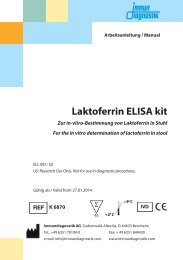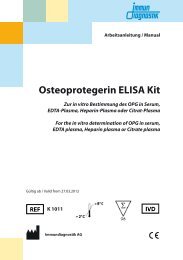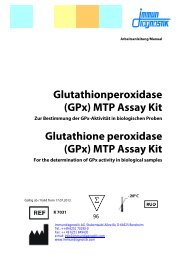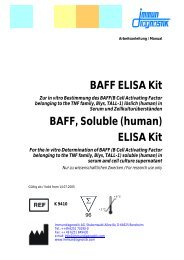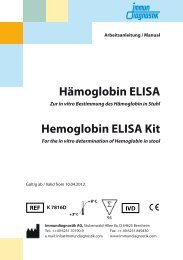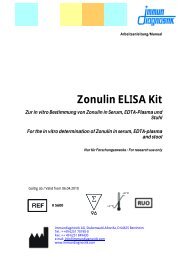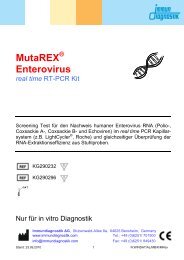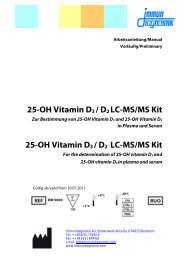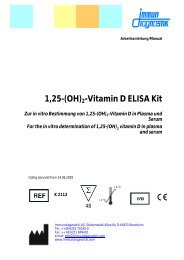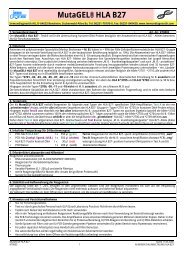MPO ELISA Kit - bei Immundiagnostik
MPO ELISA Kit - bei Immundiagnostik
MPO ELISA Kit - bei Immundiagnostik
You also want an ePaper? Increase the reach of your titles
YUMPU automatically turns print PDFs into web optimized ePapers that Google loves.
Ar<strong>bei</strong>tsanleitung / Manual<br />
<strong>MPO</strong> <strong>ELISA</strong> <strong>Kit</strong><br />
Zur in vitro Bestimmung von Myeloperoxidase (<strong>MPO</strong>) in<br />
Serum und Plasma<br />
<strong>MPO</strong> <strong>ELISA</strong> <strong>Kit</strong><br />
For the in vitro determination of Myeloperoxidase (<strong>MPO</strong>) in<br />
serum and plasma<br />
Gültig ab / Valid from 06.04.2010<br />
K 6641<br />
<strong>Immundiagnostik</strong> AG
Ar<strong>bei</strong>tsanleitung / Manual <strong>MPO</strong><br />
Inhalt<br />
1. VERWENDUNGSZWECK _______________________________________2<br />
2. EINLEITUNG _________________________________________________2<br />
3. INHALT DER TESTPACKUNG ___________________________________3<br />
4. ERFORDERLICHE LABORGERÄTE UND HILFSMITTEL ______________4<br />
5. VORBEREITUNG UND LAGERUNG DER REAGENZIEN ______________4<br />
6. PROBENVORBEREITUNG ______________________________________5<br />
Probenverdünnung ___________________________________________________ 5<br />
7. TESTDURCHFÜHRUNG ________________________________________6<br />
Testprinzip _________________________________________________________ 6<br />
Pipettierschema _____________________________________________________ 7<br />
8. ERGEBNISSE ________________________________________________8<br />
9. EINSCHRÄNKUNGEN _________________________________________8<br />
10. QUALITÄTSKONTROLLE _______________________________________9<br />
Erwartete Ergebnisse _________________________________________________ 9<br />
11. TESTCHARAKTERISTIKA ____________________________________ 10<br />
Präzision und Reproduzierbarkeit _______________________________________ 10<br />
Wiederfindung _____________________________________________________ 10<br />
Sensitivität ________________________________________________________ 10<br />
Linearität _________________________________________________________ 11<br />
Kreuzreaktivität ____________________________________________________ 11<br />
12. VORSICHTSMASSNAHMEN __________________________________ 12<br />
13. TECHNISCHE MERKMALE ___________________________________ 12<br />
14. ALLGEMEINE HINWEISE ZUM TEST ___________________________ 13<br />
15. LITERATUR ________________________________________________ 13<br />
1
Ar<strong>bei</strong>tsanleitung / Manual <strong>MPO</strong><br />
1. VERWENDUNGSZWECK<br />
Der hier beschriebene Enzyme-Linked-Immuno-Sorbent-Assay (<strong>ELISA</strong>) ist für die quantitative<br />
Bestimmung von <strong>MPO</strong> (Myeloperoxidase) in Serum und Plasma geeignet. Nur zur in vitro Diagnostik.<br />
2. EINLEITUNG<br />
<strong>MPO</strong> ist Teil des Abwehrmechanismus der polymorphnukleären Leukozyten gegen körperfremde<br />
Stoffe. Wenn es zu einer bakteriellen Infektion kommt, wandern diese Leukozyten,<br />
stimuliert durch chemotaktisch wirksame Substanzen (Leukotriene, Komplementfaktoren,<br />
Bakterientoxine u.a.), zum Infektionsort. Dort lagern sie sich an die Fremdkörper an und<br />
umschließen diese. Befindet sich der Fremdkörper in einer Vakuole, werden verschiedene<br />
Stoffe zur intrazellulären Verdauung eingesetzt: Dazu zählen <strong>MPO</strong>, kationische Proteine,<br />
Lysozym, Lactoferrin und einige saure Hydrolasen. Ein starker Schub des oxidativen Stoff-<br />
wechsels findet statt, wo<strong>bei</strong> in erhöhtem Maß Sauerstoffradikale entstehen. Durch diese<br />
Moleküle wird der Fremdstoff zerstört. Bei diesem Vorgang gelangen einige dieser Abwehrstoffe<br />
in den extrazellulären Raum. Dies geschieht besonders dann, wenn die Leukozyten den<br />
Fremdkörper aufgrund der Größe nicht umschließen können oder wenn sie selbst zerstört<br />
werden (durch Bakterientoxine, kristalline Substanzen u.a.).<br />
<strong>MPO</strong> bildet mit Wasserstoffperoxid und einem Halogen ein sehr starkes antimikrobielles<br />
System, das eine Vielzahl von Mikroorganismen wirksam bekämpfen kann. <strong>MPO</strong> ist in den<br />
neutrophilen Leukozyten in hoher Konzentration vorhanden, während Wasserstoffperoxid<br />
erst durch den Stoffwechselschub in stärkerem Maß gebildet oder durch die angegriffenen<br />
Mikroorganismen freigesetzt wird. Das <strong>MPO</strong>-System wird durch Katalase, überschüssiges H 2 O 2<br />
und einige andere Reduktionsmittel (z.B. Ascorbinsäure, Glutathion) gehemmt. Fehlen diese<br />
Substanzen, so kann das <strong>MPO</strong>-System im extrazellulären Raum auch andere Zellen angreifen.<br />
Dazu gehören Spermatozyten, Erythrozyten, Leukozyten und Tumorzellen.<br />
Auch <strong>bei</strong> nicht-infektiösen Krankheiten spielt die <strong>MPO</strong> eine Rolle, z.B. <strong>bei</strong> der Atherosklerose<br />
(<strong>MPO</strong> wurde in atherosklerotischen Läsionen nachgewiesen), <strong>bei</strong> Lungenkrebs, der Alzheimer-<br />
Krankheit oder <strong>bei</strong> der Multiplen Sklerose. Verschiedene Untersuchungen lassen vermuten,<br />
dass ein kausaler Zusammenhang zwischen <strong>MPO</strong>, Inflammation und akuten wie auch chronischen<br />
Manifestationen <strong>bei</strong> kardiovaskulären Erkrankungen besteht.<br />
Brennan et al. (2003) zeigten anhand von 604 Patienten mit Brustschmerzen, dass eine einzige<br />
initiale Messung von <strong>MPO</strong> im Serum eine unabhängige, frühe Voraussage des unmittelbaren<br />
Myokardinfarktrisikos sowie eine prognostische Abschätzung für das nächste halbe Jahr ermöglicht.<br />
Im Gegensatz zu Troponin T, der Kreatinkinase-MB-Isoform und CRP ist <strong>MPO</strong> bereits<br />
erhöht, ohne dass zuvor eine Myokardnekrose stattgefunden hat.<br />
2
Ar<strong>bei</strong>tsanleitung / Manual <strong>MPO</strong><br />
Fazit: Die Messung von <strong>MPO</strong> könnte künftig der Risikostratifizierung kardiovaskulärer<br />
Krankheiten sowohl <strong>bei</strong> chronischer Erkrankung als auch der Identifizierung von<br />
Risikopatienten dienen.<br />
Indikationen<br />
� Marker für Entzündungsaktivitäten im gastrointestinalen Bereich (Stuhl)<br />
� Nierentransplantat-Abstoßung (Urin)<br />
� Oxidativer Stress (Serum)<br />
� Zur Differenzierung von allergischem und infektbedingtem Asthma (Bronchiallavage,<br />
Atemluftkondensat, Sputum)<br />
� Verbesserte Risikoabschätzung <strong>bei</strong> Patienten mit akutem Koronarsyndrom (Serum)<br />
3. INHALT DER TESTPACKUNG<br />
Artikel Nr. Abkürzung <strong>Kit</strong> Komponenten Menge<br />
K 6641MTP PLATE Mikrotitermodul, vorbeschichtet<br />
12 x 8<br />
Vertiefungen<br />
K 6641WP WASHBUF <strong>ELISA</strong> Waschpufferkonzentrat 10x 100 ml<br />
K 6641PV SAMPLEBUF<br />
Probenverdünnungspuffer,<br />
gebrauchsfertig<br />
50 ml<br />
K 6641CAL CAL Kalibrator, lyophilisiert 4 vials<br />
K 6641KO1 CTRL<br />
K 6641KO2 CTRL<br />
K 6641K CONJ<br />
K 6641TMB SUB<br />
K 6641AC STOP<br />
Kontrolle, lyophilisiert<br />
(Bereich der Spezifikation entnehmen)<br />
Kontrolle, lyophilisiert<br />
(Bereich der Spezifikation entnehmen)<br />
Konjugat, Kaninchen anti-<strong>MPO</strong>,<br />
Peroxidase-markiert,<br />
Konzentrat<br />
TMB Substrat (Tetramethylbenzidin),<br />
gebrauchsfertig<br />
<strong>ELISA</strong> Stopplösung,<br />
gebrauchsfertig<br />
4 vials<br />
4 vials<br />
50 µl<br />
15 ml<br />
15 ml<br />
3
Ar<strong>bei</strong>tsanleitung / Manual <strong>MPO</strong><br />
4. ERFORDERLICHE LABORGERÄTE UND HILFSMITTEL<br />
4<br />
� Bidestilliertes Wasser (aqua bidest.)<br />
� Laborwaage<br />
� Präzisionspipetten und Pipettenspitzen für den Einmalgebrauch mit variablen Volumina<br />
von 10 - 1000 µl<br />
� Folie zum Abkleben der Mikrotiterplatte<br />
� Mikrotiterplattenschüttler<br />
� Multikanal- bzw. Multipipette<br />
� Zentrifuge, 3000 x g<br />
� Vortex-Mixer<br />
� Laborübliche Glas- oder Plastikröhrchen (Einmalartikel)<br />
� Mikrotiterplattenphotometer mit Filter 450 nm<br />
(Referenzfilter 620 oder 690 nm)<br />
5. VORBEREITUNG UND LAGERUNG DER REAGENZIEN<br />
� Bitte achten Sie <strong>bei</strong> mehrfachem Einsatz der Platte darauf, dass die Reagenzien, wie in<br />
der Vorschrift beschrieben, gelagert und nur die für den jeweiligen Ansatz benötigten<br />
Reagenzienmengen frisch angesetzt werden. Der <strong>Kit</strong> kann so bis zu 4 x je nach<br />
Probenaufkommen bis zum angegebenen Haltbarkeitsdatum verwendet werden.<br />
� Das WASHBUF (Waschpufferkonzentrat) muss vor Gebrauch 1:10 in bidestilliertem<br />
Wasser (aqua bidest.) verdünnt werden (100 ml Konzentrat + 900 ml aqua bidest.); gut<br />
mischen. Aufgrund der hohen Salzkonzentration in den Stammlösungen kann es zu<br />
Kristallbildungen kommen. Die Kristalle lösen sich im Wasserbad <strong>bei</strong> 37 °C auf. Das<br />
WASHBUF kann <strong>bei</strong> 2-8°C bis zum angegebenen Haltbarkeitsdatum aufbewahrt werden.<br />
Die verdünnte Pufferlösung ist <strong>bei</strong> 2-8 °C einen Monat in einem geschlossenen<br />
Gefäß haltbar.<br />
• Als BLANK (Leerwert) werden 100 µl des vorbereiteten und 1:10 verdünnten<br />
Waschpuffer pipettiert.<br />
� Der lyophilisierte CAL (Kalibrator) und die lyophilisierten CTRL (Kontrollen) sind <strong>bei</strong><br />
2-8°C bis zum angegebenen Haltbarkeitsdatum verwendbar. CAL und CTRL werden<br />
mit SAMPLEBUF (Probenverdünnungspuffer) rekonstituiert (Volumen und Konzentration<br />
siehe entsprechende Produktspezifikation) und zum Lösen 10 Minuten stehen<br />
gelassen. Rekonstituierte Kontrollen und Kalibrator sind nicht stabil und können nicht<br />
aufbewahrt werden.
Ar<strong>bei</strong>tsanleitung / Manual <strong>MPO</strong><br />
� Das CONJ (Konjugat) wird 1:500 in Waschpuffer verdünnt (20 µl CONJ + 10 ml Waschpuffer).<br />
Unverdünntes CONJ ist <strong>bei</strong> 2–8 °C bis zum angegebenen Haltbarkeitsdatum<br />
stabil. Verdünntes Konjugat ist nicht stabil und kann nicht aufbewahrt werden.<br />
� Alle anderen Testreagenzien sind <strong>bei</strong> 2-8 °C zu lagern und <strong>bei</strong> entsprechender Lagerung<br />
bis zum angegebenen Verfallsdatum (siehe Etikett) verwendbar.<br />
6. PROBENVORBEREITUNG<br />
Probenverdünnung<br />
Serum/Plasma Proben<br />
Präanalytik<br />
Bei den Untersuchungen von Plasma oder Serum können sich die ermittelten <strong>MPO</strong>-Werte<br />
deutlich unterscheiden. Die Ursachen dafür sind:<br />
� Im Serum werden während des Gerinnungsprozesses die Granulozyten zur kompletten<br />
Freisetzung der Granulozyten-Aktivierungsmarker angeregt. Die Standzeit der Proben<br />
sowie wiederholte Einfrier- und Auftauzyklen führen zu keiner Werteverschiebung.<br />
� Anders im Plasma: je länger die Probe vor dem Zentrifugationsschritt steht und je mehr<br />
Einfrier- und Auftauzyklen die Probe durchlebt, desto höhere <strong>MPO</strong> Konzentrationen<br />
werden ermittelt. Bei Verwendung von Plasma muss die Präanalytik konstant sein. Das<br />
gilt generell und unabhängig von dem verwendeten Testsystem.<br />
� Frisch abgenommenes Serum/Plasma sollte innerhalb einer Stunde abzentrifugiert<br />
werden. Es kann entweder am gleichen Tag im Test eingesetzt oder <strong>bei</strong> -20°C gelagert<br />
werden. Lipämische oder hämolysierte Proben können zu fehlerhaften Ergebnissen<br />
führen. Vor dem Einsatz im Test Proben gut mischen. Wir empfehlen alle Werte in Doppelbestimmungen<br />
zu ermitteln.<br />
Die Präanalytk ist entscheidend für akkurate und stabile/reproduzierbare <strong>MPO</strong>-Messergebnisse.<br />
� Shih et al. (2008) berichten über immer höhere <strong>MPO</strong>-Konzentrationen in Serum und<br />
Heparin-Plasma-Proben im Vergleich zu EDTA- oder Citrat-Plasma-Proben und empfehlen<br />
die Analyse von EDTA-Plasma-Proben. Ferner untersuchten die Autoren den<br />
Einfluss der Präanalytik, der Lagerungs-Temperatur und -Zeit auf die <strong>MPO</strong>-Messergebnisse<br />
von EDTA-, Lithium-Heparin- und Citrat-Plasma-Proben. Alle Proben ergaben einen<br />
Unterschied von weniger als 10% nach Lagerung <strong>bei</strong> Raumtemperatur für 2 Tage,<br />
<strong>bei</strong> 2–8 °C für 8 Tage und nach 3 Zyklen Einfrieren/Auftauen.<br />
� Videm (1996) beschreibt <strong>bei</strong> Heparin-Konzentrationen, wie <strong>bei</strong> klinischer Dosierung<br />
verwendet werden, eine dosisabhängige Erhöhung der Granulozyten-Aktivität, die<br />
5
Ar<strong>bei</strong>tsanleitung / Manual <strong>MPO</strong><br />
6<br />
durch quantitative <strong>ELISA</strong> Bestimmung der <strong>MPO</strong>-Freisetzung untersucht wurde. Daher<br />
sollte <strong>bei</strong> der Auswertung der <strong>MPO</strong>-Ergebnisse für Proben von Patienten unter systematischer<br />
Heparintherapie der direkte Einfluss von Heparin auf Granulozyten bzw. auf<br />
die <strong>MPO</strong>-Freisetzung und -Konzentration berücksichtigt werden.<br />
Serumproben<br />
Serumproben werden vor dem Einsatz im Test 1:40 in SAMPLEBUF (Probenverdünnungspuffer)<br />
verdünnt.<br />
Zum Beispiel: 25 µl Probe + 975 µl SAMPLEBUF.<br />
EDTA-Plasmaproben<br />
Plasmaproben werden vor dem Einsatz im Test 1:10 in SAMPLEBUF (Probenverdünnungspuffer)<br />
verdünnt.<br />
Zum Beispiel: 100 µl Probe + 900 µl SAMPLEBUF.<br />
7. TESTDURCHFÜHRUNG<br />
Testprinzip<br />
Der Test basiert auf der “Sandwich”-<strong>ELISA</strong> Technik. Es werden zwei ausgewählte polyklonale<br />
Antikörper, die humanes <strong>MPO</strong> erkennen, verwendet.<br />
Teststandards, Kontrollen und verdünnte Proben, die <strong>MPO</strong> enthalten, werden in eine<br />
Mikrotiterplatte pipettiert, deren Vertiefungen mit einem hochaffinen polyklonalen<br />
anti-human <strong>MPO</strong> Antikörper beschichtet wurden. In diesem ersten Inkubationsschritt<br />
wird die <strong>MPO</strong> aus der Probe von dem gekoppelten Fängerantikörper gebunden. Dann<br />
wird das Konjugat (ein Peroxidase markierter polyklonaler anti-<strong>MPO</strong> Antikörper) zugegeben<br />
und es bildet sich folgender Komplex an der Wand der Mikrotiterplatte: Fängerantikörper<br />
- humanes <strong>MPO</strong> – Peroxidase Konjugat. Als Peroxidasesubstrat wird<br />
Tetramethylbenzidin (TMB) eingesetzt. Die Enzymreaktion wird durch Zugabe von Säure<br />
abgestoppt. Dadurch folgt ein Farbumschlag von blau nach gelb. Die entstandene chromogene<br />
Verbindung wird photometrisch <strong>bei</strong> 450 nm gemessen. Die Intensität der Farbe<br />
ist dem <strong>MPO</strong>-Gehalt direkt proportional. Anhand eines mitgeführten Kalibrators und<br />
dessen Bezug zu einer chargenabhängigen Mustereichkurve lässt sich die Konzentration<br />
der Probe ermitteln.
Ar<strong>bei</strong>tsanleitung / Manual <strong>MPO</strong><br />
Pipettierschema<br />
Im Test dürfen nur Reagenzien und Proben verwendet werden, welche Raumtemperatur<br />
(18-26°C) aufweisen. Vor Gebrauch Reagenzien und Proben gut mischen<br />
Positionen für BLANK/CAL/CTRL/SAMPLE (Leewert / Kalibrator / Kontrollen / Probe)<br />
in Doppelbestimmung am Protokollblatt markieren<br />
Nehmen Sie die benötigten Mikrotiterstreifen aus dem <strong>Kit</strong>. Nicht verwendete<br />
Mikrotiterstreifen können abgeklebt bis zum angegebenen Haltbarkeitsdatum <strong>bei</strong><br />
2-8 °C gelagert werden<br />
Waschen Sie die Mikrotiterstreifen 5x mit je 250 µl verdünntem WASHBUF (Waschpuffer).<br />
Nach dem letzten Waschschritt Reste von Waschpuffer durch Ausklopfen auf<br />
saugfähigem Papier entfernen<br />
100 µl für BLANK/CAL/CTRL/SAMPLE (Leewert / Kalibrator / Kontrollen / Probe) in die<br />
jeweiligen Vertiefungen pipettieren<br />
Streifen abdecken und 1 Stunde <strong>bei</strong> Raumtemperatur (18-26°C) unter Schütteln<br />
inkubieren<br />
Inhalt der Vertiefungen verwerfen und 5x mit je 250 µl verdünntem WASHBUF<br />
(Waschpuffer) waschen. Nach dem letzten Waschschritt Reste von Waschpuffer durch<br />
Ausklopfen auf saugfähigem Papier entfernen<br />
Pipettieren Sie 100 µl CONJ (Konjugat) in alle Vertiefungen<br />
Streifen abdecken und 1 Stunde <strong>bei</strong> Raumtemperatur (18-26°C) unter Schütteln<br />
inkubieren<br />
Inhalt der Vertiefungen verwerfen und 5x mit je 250 µl verdünntem WASHBUF<br />
(Waschpuffer) waschen. Nach dem letzten Waschschritt Reste von Waschpuffer durch<br />
Ausklopfen auf saugfähigem Papier entfernen<br />
Pipettieren Sie 100 µl SUB (Substrat) in alle Vertiefungen<br />
10 - 20 Minuten <strong>bei</strong> Raumtemperatur (18-26°C) im Dunkeln inkubieren*<br />
Pipettieren Sie 50 µl STOP (Stopplösung) in alle Vertiefungen, gut mischen<br />
Extinktion sofort im Mikrotiterplattenphotometer <strong>bei</strong> 450 nm gegen die Referenzwellenlänge<br />
620 nm (oder 690 nm) messen. Ist keine Referenzwellenlänge vorhanden<br />
wird nur <strong>bei</strong> 450 nm gelesen. Falls die Extinktion des höchsten Standards den<br />
Meßbereich des Photometers übersteigt, sollte sofort <strong>bei</strong> 405 nm gegen 620 nm (690<br />
nm) gemessen werden<br />
* Die Intensität der Farbentwicklung ist temperaturabhängig. Es wird empfohlen den Farbumschlag während der<br />
Inkubationszeit zu beobachten und entsprechend der Farbentwicklung die Reaktion zu stoppen<br />
7
Ar<strong>bei</strong>tsanleitung / Manual <strong>MPO</strong><br />
8. ERGEBNISSE<br />
8<br />
Für die Auswertung der Messwerte verwenden Sie bitte ein 4-parametrisches Logit-Log<br />
Model unter Verwendung der Angaben zu dem Verlauf der Kalibrationskurve sowie der<br />
optischen Dichte des Kalibrators (CAL), welche auf dem QC-Datenblatt der jeweiligen<br />
<strong>Kit</strong>charge zu finden sind.<br />
Abhängig von der verwendeten Software kann der Kalibrationskurvenverlauf sowohl<br />
durch die Parameter A, B, C und D als auch durch die Wertepaare aus Konzentration und<br />
optischer Dichte der Standards beschrieben werden.<br />
Achtung: Die Parameterwerte müssen genau eingegeben werden, da selbst geringe Abweichungen<br />
der Zahlenwerte zu massiven Störungen der Auswertung führen können.<br />
Nach jeder Auswertung sollte stets eine Kontrolle der Doppelwerte auf Plausibilität<br />
(„Ausreißerkontrolle“) durchgeführt werden; falls dies nicht durch das verwendete Programm<br />
erfolgt, sollte diese der Operator durchführen.<br />
Serum/Plasma Proben<br />
Um die Konzentration in Serum zu bestimmen, wird der ermittelte <strong>MPO</strong>-Wert mit<br />
40 multipliziert.<br />
Um die Konzentration in Plasma zu bestimmen, wird der ermittelte <strong>MPO</strong>-Wert mit<br />
10 multipliziert.<br />
9. EINSCHRÄNKUNGEN<br />
Serum/Plasma mit <strong>MPO</strong> Konzentrationen, die größer als der höchste Standard sind werden<br />
mit Probenverdünnungspuffer verdünnt und nochmals bestimmt.
Ar<strong>bei</strong>tsanleitung / Manual <strong>MPO</strong><br />
10. QUALITÄTSKONTROLLE<br />
Wir empfehlen Kontrollen <strong>bei</strong> jedem Testansatz mitzumessen. Die Ergebnisse der Kontrollen<br />
müssen auf Richtigkeit überprüft werden. Liegt einer oder mehrere Werte außerhalb<br />
des angegebenen Bereiches, kann <strong>Immundiagnostik</strong> AG die Richtigkeit der Werte<br />
nicht gewährleisten.<br />
Erwartete Ergebnisse<br />
Normwerte<br />
<strong>MPO</strong> aus Serum (n = 42 ): Mittelwert 340 ng/ml (SD 176.7)<br />
<strong>MPO</strong> aus EDTA-Plasma (n = 41): Mittelwert 98.31 ng/ml (SD 62.9)<br />
Anhand einer laborinternen Studie mit Proben von augenscheinlich Gesunden wurden<br />
die Mittelwerte berechnet.<br />
Wir empfehlen jedem Labor einen eigenen Normwertbereich zu etablieren.<br />
9
Ar<strong>bei</strong>tsanleitung / Manual <strong>MPO</strong><br />
11. TESTCHARAKTERISTIKA<br />
10<br />
Präzision und Reproduzierbarkeit<br />
Intra-Assay (n=20)<br />
Probe<br />
<strong>MPO</strong><br />
(ng/ml)<br />
Vk<br />
(%)<br />
1 147.1 4.3<br />
2 288.6 4.8<br />
Inter-Assay (n=20)<br />
Probe<br />
<strong>MPO</strong><br />
(ng/ml)<br />
Vk<br />
(%)<br />
1 171.7 12<br />
2 239.9 15<br />
Wiederfindung<br />
2 Proben wurden mit 3 unterschiedlichen <strong>MPO</strong> Standardmengen versetzt und gemessen.<br />
Probe<br />
(ng/ml)<br />
Sensitivität<br />
Spike<br />
(ng/ml)<br />
<strong>MPO</strong> erwartet<br />
(ng/ml)<br />
<strong>MPO</strong> gemessen<br />
(ng/ml)<br />
116 320 436 401<br />
116 200 316 336<br />
116 125 241 254<br />
92 320 412 388<br />
92 200 292 297<br />
92 125 217 204<br />
Die Nachweisgrenze wurde festgelegt als B 0 + 2 SD. Gemessen wurde 20-mal der Standard<br />
null.<br />
Probe<br />
<strong>MPO</strong> Mittelwert<br />
(OD)<br />
Standard-<br />
abweichung (SD)<br />
Nachweisgrenze<br />
(ng/ml)<br />
1 0.013 0.003 1.6
Ar<strong>bei</strong>tsanleitung / Manual <strong>MPO</strong><br />
Linearität<br />
Zwei Patientenproben wurden mit Probenverdünnungspuffer verdünnt und im Test gemessen.<br />
Die Ergebnisse sind in der unten stehenden Tabelle aufgeführt.<br />
Probe Verdünnung<br />
A<br />
B<br />
Kreuzreaktivität<br />
Erwartet<br />
(ng/ml)<br />
Gemessen<br />
(ng/ml)<br />
1:40 14.5 14.5<br />
1:80 7.2 7.1<br />
1:160 3.6 3.5<br />
1:40 19.5 19.5<br />
1:80 9.75 10.1<br />
1:160 4.8 5.2<br />
Es wurde keine Kreuzreaktivität zu anderen Plasmaproteinen im Serum/Plasma gefunden.<br />
Alpha-1-Antitrypsin 0 %<br />
Albumin 0 %<br />
CRP 0 %<br />
Lysozym 0 %<br />
sIgA 0 %<br />
PMN-Elastase 0 %<br />
Calprotectin 0 %<br />
Es wurde keine Kreuzreaktivität mit <strong>MPO</strong> im Mausserum gefunden.<br />
11
Ar<strong>bei</strong>tsanleitung / Manual <strong>MPO</strong><br />
12. VORSICHTSMASSNAHMEN<br />
12<br />
� Nur zur in vitro Diagnostik.<br />
� Qualitätskontrollen sollten immer mit gemessen werden.<br />
� Das für <strong>Kit</strong>komponenten verwendete humane Material wurde auf HIV, Hepatitis B und<br />
Hepatitis C getestet und für negativ befundet. Dennoch wird empfohlen, die <strong>Kit</strong>komponenten<br />
immer wie potentiell infektiöses Material zu behandeln.<br />
� Die <strong>Kit</strong>komponenten enthalten zum Schutz vor bakteriellen Kontaminationen<br />
Natriumazid oder Thimerosal. Natriumazid bzw. Thimerosal sind giftig. Substrate<br />
für enzymatische Farbreaktionen sind als giftig und karzinogen beschrieben. Jeder<br />
Kontakt mit Haut oder Schleimhaut ist zu vermeiden.<br />
� Die Stopplösung besteht aus verdünnter Schwefelsäure (H 2 SO 4 ). H 2 SO 4 ist eine starke<br />
Säure und muss auch in verdünnter Form mit Vorsicht benutzt werden. H 2 SO 4 verursacht<br />
<strong>bei</strong> Kontakt mit der Haut Verätzungen. Es sollte daher mit Schutzhandschuhen,<br />
Schutzkleidung und Schutzbrille gear<strong>bei</strong>tet werden. Bei Kontakt mit der Säure muss<br />
die verätzte Stelle sofort mit viel Wasser gespült werden.<br />
13. TECHNISCHE MERKMALE<br />
� Reagenzien der <strong>Kit</strong>packung dürfen nicht mit anderen Chargen gemischt werden.<br />
� Die Reagenzien dürfen nach Ablauf des Mindesthaltbarkeitsdatums nicht mehr<br />
verwendet werden.<br />
� Substratlösung muss vor Gebrauch farblos sein.<br />
� Mikrotiterstreifen müssen <strong>bei</strong> den Inkubationen mit Folie abgedeckt sein.<br />
� Vermeiden Sie Schaumbildung <strong>bei</strong>m Mischen der Reagenzien.<br />
� Der Assay ist immer nach der im <strong>Kit</strong> <strong>bei</strong>gefügten Ar<strong>bei</strong>tsanleitung durchzuführen.
Ar<strong>bei</strong>tsanleitung / Manual <strong>MPO</strong><br />
14. ALLGEMEINE HINWEISE ZUM TEST<br />
� Dieser <strong>Kit</strong> wurde nach der IVD Richtlinie 98/79/EG hergestellt und in den Verkehr<br />
gebracht.<br />
� Alle im <strong>Kit</strong> enthaltenen Reagenzien dürfen ausschließlich zur in vitro Diagnostik<br />
verwendet werden.<br />
� Für die Qualitätskontrolle sind die für medizinische Laboratorien erstellten Richtlinien<br />
zu beachten.<br />
� Die charakteristischen Testdaten wie Inkubationszeiten, Inkubationstemperaturen<br />
und Pipettiervolumina der verschiedenen Komponenten wurden firmenintern festgelegt.<br />
Nicht mit dem Hersteller abgesprochene Veränderungen in der Testdurchführung<br />
können die Resultate beeinflussen. Die Firma <strong>Immundiagnostik</strong> AG übernimmt für die<br />
hierdurch entstandenen Schäden und Folgeschäden keine Haftung.<br />
� Bei Gewährleistungsansprüchen ist das beanstandete Material mit schriftlicher Erklärung<br />
innerhalb von 14 Tagen zum Hersteller - der <strong>Immundiagnostik</strong> AG zurück zu senden.<br />
15. LITERATUR<br />
Publikationen zum <strong>Immundiagnostik</strong> <strong>MPO</strong>-<strong>ELISA</strong>:<br />
� Exner M et al. (2006) JACC 47 (11) 2212-2218<br />
� Holz O et al. (2005) J Clin Pharmacol 45(5):498-503<br />
� Stepan H et al. (2003) Hypertens Pregnancy 22(3):239-45<br />
� Stepan H et al. (2002) Poster zum 10. Kongress der DGPG<br />
Allgemeine Publikationen:<br />
� Klebanoff SJ (1999) Proc Assoc Am Physicians 111(5):383-9<br />
� Oremek et al. (1995) MTA 4: 273-278<br />
� Markant et al. Pharmazeutische Zeitung 26/1995, 140. Jahrgang: 9-25<br />
� Saiki (1998) Kurume Med J 45: 69-73<br />
� Zhang R et al. (2001) JAMA 286 : 2136-2142<br />
� Brennan M et al. (2003) N Engl J Med 349 : 1595-1604<br />
� Baldus S et al. (2003) Circulation 108 : 1440-1445<br />
� Shih et al. (2008) Affect of Collection Tube Type and Preanalytical Handling on Myeloperoxidase<br />
Concentrations Clinical Chemistry 54:6 1076–1079<br />
� Videm V. (1996) Heparin in clinical doses ‚primes‘ granulocytes to subsequent activation<br />
as measured by myeloperoxidase release. Scand J Immunol. Apr;43(4):385-90<br />
13
Ar<strong>bei</strong>tsanleitung / Manual <strong>MPO</strong><br />
14<br />
Verwendete Symbole:<br />
Temperaturbegrenzung Bestellnummer<br />
In-Vitro-Diagnostikum<br />
Inhalt ausreichend für <br />
Prüfungen<br />
Hersteller Verwendbar bis<br />
Chargenbezeichnung
Manual<br />
<strong>MPO</strong> <strong>ELISA</strong> <strong>Kit</strong><br />
For the in vitro determination of Myeloperoxidase (<strong>MPO</strong>) in<br />
serum and plasma<br />
Valid from 06.04.2010<br />
K 6641<br />
<strong>Immundiagnostik</strong> AG
Ar<strong>bei</strong>tsanleitung / Manual <strong>MPO</strong><br />
Content<br />
1. INTENDED USE ____________________________________________ 17<br />
2. INTRODUCTION ___________________________________________ 17<br />
3. MATERIAL SUPPLIED _______________________________________ 18<br />
4. MATERIAL REQUIRED BUT NOT SUPPLIED _____________________ 19<br />
5. PREPARATION AND STORAGE OF REAGENTS ___________________ 19<br />
6. SAMPLE PREPARATION _____________________________________ 20<br />
16<br />
Dilution of samples __________________________________________________ 20<br />
7. ASSAY PROCEDURE ________________________________________ 21<br />
Principle of the test __________________________________________________ 21<br />
Test procedure ______________________________________________________ 22<br />
8. RESULTS __________________________________________________ 23<br />
9. LIMITATIONS ______________________________________________ 23<br />
10. QUALITY CONTROL ________________________________________ 24<br />
Expected values ____________________________________________________ 24<br />
11. PERFORAMANCE CHARACTERISTICS __________________________ 25<br />
Precision and reproducibility __________________________________________ 25<br />
Recovery __________________________________________________________ 25<br />
Sensitivity _________________________________________________________ 25<br />
Linearity __________________________________________________________ 26<br />
Cross reactivity _____________________________________________________ 26<br />
12. PRECAUTIONS _____________________________________________ 27<br />
13. TECHNICAL HINTS _________________________________________ 27<br />
14. GENERAL NOTES ON THE TEST AND TEST PROCEDURE __________ 28<br />
15. REFERENCES ______________________________________________ 28
Ar<strong>bei</strong>tsanleitung / Manual <strong>MPO</strong><br />
1. INTENDED USE<br />
The described Enzyme-Linked-Immuno-Sorbent-Assay (<strong>ELISA</strong>) is intended for the quantitative<br />
determination of <strong>MPO</strong> (Myeloperoxidase) in serum and plasma. It is for in vitro diagnostic use<br />
only.<br />
2. INTRODUCTION<br />
<strong>MPO</strong> is part of the defence mechanism of the polymorphonuclear leukocytes against exogenic<br />
substances. During bacterial infection, these leukocytes, are stimulated by chemotactically<br />
effective substances (leukotrienes, complement factors, bacterial toxins etc.). They move to<br />
the site of the infection and encapsulate the foreign substances. If the foreign agent is located<br />
in an intracellular vacuole, different substances are used for the intracellular digestion.<br />
Amongst these are <strong>MPO</strong>, cationic proteins, lysozyme, lactoferrin and some acidic hydrolases. A<br />
strong surge of oxidative metabolism takes place, producing a high number of oxygen radicals<br />
which leads to the destruction of foreign proteins. Some of these molecules can leak into the<br />
extracellular space during this process. This happens to a greater extent, when the leukocytes<br />
cannot encapsulate the foreign body because of its size or in cases where the neutrophils are<br />
destroyed (by bacterial toxins, crystalline substances etc.).<br />
<strong>MPO</strong>, together with hydrogen peroxide and a halogen, forms a very strong anti microbial<br />
system, which can effectively combat a number of microorganisms. <strong>MPO</strong> is present at high<br />
concentration in neutrophil granulocytes, whereas hydrogen peroxide is produced during<br />
infection/ inflammation. The <strong>MPO</strong> system is inhibited by catalase, excess of hydrogen<br />
peroxide and other reducing substances (e.g. ascorbic acid, glutathione). In the absence of<br />
these agents other cells in the extracellular space can be affected (e.g. spermatocyte, erythrocytes,<br />
leukocytes, and tumor cells)<br />
Apart from its implications in host defence, involvement of <strong>MPO</strong> has been described in numerous<br />
non-infectious diseases such as atherosclerosis, lung cancer, Alzheimer´s disease, and<br />
multiple sclerosis. <strong>MPO</strong> is present and active within atherosclerotic lesions. Numerous lines of<br />
evidence suggest mechanistic links between myeloperoxidase, inflammation and both acute<br />
and chronic manifestations of cardiovascular disease.<br />
Brennan et al. (2003) showed that in 604 sequentially ascertained patients presenting with<br />
chest pain, a single initial measurement of plasma myeloperoxidase was an independent early<br />
predictor of myocardial infarction, as well as the risk of major adverse cardiac events in ensuing<br />
30-day and 6-month periods. In contrast to troponin T, creatine kinase MB isoform, and<br />
C-reactive protein levels, <strong>MPO</strong> levels may identify patients at risk for cardiac events in the absence<br />
of myocardial necrosis.<br />
17
Ar<strong>bei</strong>tsanleitung / Manual <strong>MPO</strong><br />
Summary: The inflammatory protein myeloperoxidase is present, active and mechanistically<br />
poised to participate in the initiation and progression of cardiovascular disease.<br />
The many links between myeloperoxidase, oxidation and cardiovascular disease<br />
suggest this leukocyte protein may have clinical utility in risk stratification for cardiovascular<br />
disease status and outcomes.<br />
Indications<br />
18<br />
� Marker for inflammatory activities in the gastrointestinal tract (Stool)<br />
� Renal transplant rejection (Urine)<br />
� Oxidative stress (Serum)<br />
� For the differentiation between allergic and infectious asthma (bronchial lavage, respiratory<br />
condensate, sputum)<br />
� Prediction of risk in patients with acute coronary syndromes (Serum)<br />
3. MATERIAL SUPPLIED<br />
Catalotue No Content <strong>Kit</strong> Components Quantity<br />
K 6641MTP PLATE One holder with precoated strips 12 x 8 wells<br />
K 6641WP WASHBUF <strong>ELISA</strong> wash buffer concentrate 10x 100 ml<br />
K 6641PV SAMPLEBUF<br />
Sample dilution buffer,<br />
ready-to-use<br />
50 ml<br />
K 6641CAL CAL Calibrator, lyophilized 4 vials<br />
K 6641KO1 CTRL<br />
K 6641KO2 CTRL<br />
K 6641K CONJ<br />
K 6641TMB SUB<br />
Control, lyophilized<br />
(see specification for range)<br />
Control, lyophilized<br />
(see specification for range)<br />
Conjugate, rabbit anti-<strong>MPO</strong> peroxidase<br />
labelled antibody, concentrate<br />
TMB substrate (Tetramethylbenzidine),<br />
ready to use<br />
K 6641AC STOP <strong>ELISA</strong> stop solution, ready to use<br />
4 vials<br />
4 vials<br />
50 µl<br />
15 ml<br />
15 ml
Ar<strong>bei</strong>tsanleitung / Manual <strong>MPO</strong><br />
4. MATERIAL REQUIRED BUT NOT SUPPLIED<br />
� Bidistilled water (aqua bidest.)<br />
� Laboratory balance<br />
� Precision pipettors calibrated and tips to deliver 10-1000 µl<br />
� Foil to cover the microtiter plate<br />
� Horizontal microtiter plate shaker<br />
� A multi-channel dispenser or repeating dispenser<br />
� Centrifuge capable of 3000 x g<br />
� Vortex-Mixer<br />
� Standard laboratory glass or plastic vials, cups, etc.<br />
� Microtiter plate reader at 450 nm<br />
(reference wave length 620 or 690 nm)<br />
5. PREPARATION AND STORAGE OF REAGENTS<br />
� To run the assay more than one time, make sure that the reagents are stored at the conditions<br />
stated on the label. Prepare just the appropriate amount necessary for the<br />
assay. The kit can be used up to 4 times within the expiry date stated on the label.<br />
� The <strong>ELISA</strong> WASHBUF (wash buffer concentrate) should be diluted with aqua bidest.<br />
1:10 before use (100 ml concentrate + 900 ml a. bidest.), mix well. Crystals can occur<br />
due to high salt concentration in the stock solutions. The crystals must be redissolved<br />
at 37°C in a water bath before dilution of the buffer solutions. The WASHBUF is stable<br />
at 2-8°C until the expiry date stated on the label. Diluted buffer solution can be stored<br />
in a closed flask at 2-8°C for one month.<br />
• Use 100 µl of diluted wash buffer as a BLANK. Pipette into the respective well.<br />
� The lyophilized CAL (calibrator) and the lyophilized CTRL (controls) are stable at<br />
2-8°C until the expiry date stated on the label. Reconstitute CAL (calibrator) and CTRL<br />
(controls) with SAMPLEBUF (sample dilution buffer) (volume and concentration, see<br />
product specification). Allow the vial content to solve for 10 minutes and then mix<br />
thoroughly by gentle inversion to insure complete reconstitution. Reconstituted calibrator<br />
and control are not stable.<br />
� The CONJ (conjugate) must be diluted 1:500 in diluted wash buffer (20 µl CONJ +<br />
10 ml diluted wash buffer). The conjugate is stable at 2-8 °C until expiry date stated on<br />
the label. Diluted conjugate is not stable and can not be stored.<br />
19
Ar<strong>bei</strong>tsanleitung / Manual <strong>MPO</strong><br />
20<br />
� All other test reagents are ready to use. The test reagents are stable until the expiry<br />
date (see label of test package) when stored at 2-8°C.<br />
6. SAMPLE PREPARATION<br />
Dilution of samples<br />
Serum/plasma samples<br />
Preanalytic handling<br />
Significant differences in the <strong>MPO</strong> levels can be observed due to different sample preparation<br />
procedures, e.g. analysis of plasma or serum samples. The reasons are as follows:<br />
� The granulocytes are activated during the serum clotting and release granulocyte-activating<br />
markers. The time between serum collecting and analysis as well as repeated<br />
freeze-thaw cycles don‘t cause a <strong>MPO</strong> concentration shift.<br />
� On the contrary, in the case of plasma samples, varying the time between sampling<br />
and analysis or the number of freeze-thaw cycles will cause variation in the observed<br />
<strong>MPO</strong> levels. Therefore, the preanalytical conditions of plasma samples should be held<br />
constant. This is a general requirement independent of the test-system used.<br />
� Fresh collected Serum/Plasma should be centrifuged within one hour. Store samples at<br />
-20 °C if not assayed on the same day. Lipemic or hemolytic samples may give erroneous<br />
results. Samples should be mixed well before assaying. We recommend duplicate<br />
analyses for each sample.<br />
The preanalytical handling is critical for accurate and consistent/reproducible <strong>MPO</strong> measurement<br />
results.<br />
� Shih et al. (2008) report that <strong>MPO</strong> concentrations were consistently higher in serum<br />
and heparin plasma samples than in samples in EDTA or citrate and recommend the<br />
analysis of EDTA plasma samples. Furthermore, the authors investigated the effects of<br />
preanalytical handling, storage temperature and time for EDTA plasma, lithium-heparin<br />
and citrate preparation. Less than 10% differences were found after storage of<br />
samples at room temperature for 2 days, after storage at 2–8 °C for 8 days, and after 3<br />
freeze-thaw cycles for all sample types<br />
� Videm (1996) describes at heparin concentrations, as applied in clinical practice, a dose-dependent<br />
increase in granulocyte activation as measured by <strong>MPO</strong> release, quantitated<br />
in enzyme-immunoassay. Thus, direct effects of heparin on granulocytes, e.g.<br />
<strong>MPO</strong> release and concentration, should be taken into consideration for the evaluation<br />
of <strong>MPO</strong> results of samples from patients receiving systemic heparin therapy.
Ar<strong>bei</strong>tsanleitung / Manual <strong>MPO</strong><br />
Serum samples<br />
Prior to analyses the serum samples should be diluted 1:40 with SAMPLEBUF (sample<br />
dilution buffer).<br />
For example: 25 µl sample + 975 µl SAMPLEBUF.<br />
EDTA-plasma samples<br />
Prior to analyses the EDTA-plasma samples should be diluted 1:10 with SAMPLEBUF<br />
(sample dilution buffer).<br />
For example: 100 µl sample + 900 µl SAMPLEBUF.<br />
7. ASSAY PROCEDURE<br />
Principle of the test<br />
The assay utilizes the two-site “sandwich” technique with two selected polyclonal antibodies<br />
that bind to human <strong>MPO</strong>.<br />
Assay standards, controls and prediluted patient samples containing human <strong>MPO</strong> are<br />
added to wells of microplate that was coated with a high affine polyclonal anti-human<br />
<strong>MPO</strong> antibody. After the first incubation period, antibody immobilized on the wall of<br />
microtiter wells captures human <strong>MPO</strong> in the sample. Then a peroxidase-conjugated<br />
polyclonal anti-human <strong>MPO</strong> antibody is added to each microtiter well and a “sandwich”<br />
of capture antibody - human <strong>MPO</strong> – Peroxidase conjugate is formed. Tetramethylbenzidine<br />
(TMB) is used as a substrate for peroxidase. Finally an acidic stop solution is added to<br />
terminate the reaction. The color changes from blue to yellow. The intensity of the yellow<br />
color is directly proportional to the concentration of <strong>MPO</strong> in the sample. Samples are<br />
quantified by referring their optical density to a Lot-dependant master calibration curve<br />
and the use of a Calibrator that is run with each test.<br />
21
Ar<strong>bei</strong>tsanleitung / Manual <strong>MPO</strong><br />
22<br />
Test procedure<br />
Prior to use in the assay allow all reagents and samples to come to room temperature<br />
(18-26 °C) and mix well.<br />
Mark the positions of BLANK/CAL/CTRL/SAMPLE (Blank / Calibrator / Controls / Sample)<br />
in duplicate on a protocol sheet<br />
Take the required microtiter strips out of the kit. Store unused strips covered at<br />
2-8° C. Strips are stable until expiry date stated on the label.<br />
Wash each well 5 times by dispending 250 µl of diluted WASHBUF (Wash buffer) into<br />
each well. After the final washing step the inverted microtiter plate should be firmly<br />
tapped on absorbent paper.<br />
Add 100 µl of BLANK/CAL/CTRL/SAMPLE (Blank / Calibrator / Controls / Sample) in<br />
duplicate into respective well<br />
Cover the plate tightly and incubate for 1 hour at room temperature (18-26°C) on a<br />
horizontal mixer<br />
Aspirate the contents of each well. Wash 5 times by dispending 250 µl of diluted<br />
WASHBUF (Wash buffer) into each well. After the final washing step the inverted microtiter<br />
plate should be firmly tapped on absorbent paper.<br />
Add 100 µl CONJ (Conjugate) into each well.<br />
Cover the plate tightly and incubate for 1 hour at room temperature (18-26°C) on a<br />
horizontal mixer.<br />
Aspirate the contents of each well. Wash 5 times by dispending 250 µl of diluted<br />
WASHBUF (Wash buffer) into each well. After the final washing step the inverted microtiter<br />
plate should be firmly tapped on absorbent paper.<br />
Add 100 µl of SUB (Substrate) into each well.<br />
Incubate for 10 - 20 minutes at room temperature (18-26°C) in the dark.*<br />
Add 50 µl of STOP (stop solution) into each well, mix thoroughly.<br />
Determine absorption immediately with an <strong>ELISA</strong> reader at 450 nm against 620 nm<br />
(or 690 nm) as a reference. If no reference wavelength is available, read only at 450 nm.<br />
If the extinction of the highest standard exceeds the range of the photometer, absorption<br />
must be measured immediately at 405 nm against 620 nm as a reference<br />
* The intensity of the color change is temperature sensitive. We recommend to observe the procedure of the color<br />
change and to stop the reaction upon good differentiation
Ar<strong>bei</strong>tsanleitung / Manual <strong>MPO</strong><br />
8. RESULTS<br />
For result evaluation, please use a four parametric logit-log model based on the standard<br />
curve of the respective kit lot and the Calibrator value (CAL). All essential information on<br />
the standard curve is provided on the QC data sheet of the respective product lot.<br />
The calibration curve can be expressed either by the concentration of each standard with<br />
its corresponding optical density or by the four parameters A, B, C and D. In both cases the<br />
optical density of the calibrator (CAL) is essential.<br />
Depending on your evaluation software program, either the one or the other kind of data<br />
described above should be entered.<br />
Caution: Please make sure that all parameters and values are transferred accurately into<br />
your software as minor deviations can cause severe errors during evaluation.<br />
The plausibility of replicate values should always be examined after automatic evaluation<br />
of the results. If this option is not available with the used program, a control of the<br />
replicate values should be done manually by the operator.<br />
Serum/plasma samples<br />
For the calculation of the <strong>MPO</strong> concentration in serum samples the result has to be<br />
multiplied by 40.<br />
For the calculation of the <strong>MPO</strong> concentration in plasma samples the result has to be<br />
multiplied by 10.<br />
9. LIMITATIONS<br />
Serum/plasma with <strong>MPO</strong> levels greater than the highest standard value should be<br />
diluted with sample dilution buffer and re-assayed.<br />
23
Ar<strong>bei</strong>tsanleitung / Manual <strong>MPO</strong><br />
10. QUALITY CONTROL<br />
24<br />
Control samples should be analyzed with each run. Results, generated from the analysis<br />
of control samples, should be evaluated for acceptability using appropriate statistical<br />
methods. The results for the patient sample may not be valid, if within the same assay one<br />
or more values of the quality control sample are outside the acceptable limits.<br />
Expected values<br />
Normal ranges<br />
<strong>MPO</strong> in serum (n = 42 ): mean 340 ng/ml (SD 176.7)<br />
<strong>MPO</strong> in EDTA-plasma (n = 41): mean 98.31 ng/ml (SD 62.9)<br />
Based on <strong>Immundiagnostik</strong> AG studies of evidently healthy persons a mean value was<br />
estimated.<br />
We recommend each laboratory to establish its own norm concentration range.
Ar<strong>bei</strong>tsanleitung / Manual <strong>MPO</strong><br />
11. PERFORAMANCE CHARACTERISTICS<br />
Precision and reproducibility<br />
Intra-Assay (n=20)<br />
Sample<br />
<strong>MPO</strong><br />
(ng/ml)<br />
CV<br />
(%)<br />
1 147.1 4.3<br />
2 288.6 4.8<br />
Inter-Assay (n=20)<br />
Sample<br />
<strong>MPO</strong><br />
(ng/ml)<br />
CV<br />
(%)<br />
1 171.7 12<br />
2 239.9 15<br />
Recovery<br />
2 samples were spiked with 3 different <strong>MPO</strong> standards and measured using this assay.<br />
Sample<br />
(ng/ml)<br />
Sensitivity<br />
Spike<br />
(ng/ml)<br />
<strong>MPO</strong> expected<br />
(ng/ml)<br />
<strong>MPO</strong> measured<br />
(ng/ml)<br />
116 320 436 401<br />
116 200 316 336<br />
116 125 241 254<br />
92 320 412 388<br />
92 200 292 297<br />
92 125 217 204<br />
The sensitivity was set as B 0 + 2SD. The zero-standard was measured 20 times.<br />
Sample<br />
<strong>MPO</strong> mean value<br />
(OD)<br />
Standard variation<br />
(SD)<br />
Detection limit<br />
(ng/ml)<br />
1 0.013 0.003 1.6<br />
25
Ar<strong>bei</strong>tsanleitung / Manual <strong>MPO</strong><br />
26<br />
Linearity<br />
Two patient samples were diluted with sample dilution buffer and analyzed. The results are<br />
shown below:<br />
Sample Dilution<br />
A<br />
B<br />
Cross reactivity<br />
Expected<br />
(ng/ml)<br />
Measured<br />
(ng/ml)<br />
1:40 14.5 14.5<br />
1:80 7.2 7.1<br />
1:160 3.6 3.5<br />
1:40 19.5 19.5<br />
1:80 9.75 10.1<br />
1:160 4.8 5.2<br />
No cross reactivity with other plasma proteins in serum/plasma was observed.<br />
Alpha-1-Antitrypsin 0 %<br />
Albumin 0 %<br />
CRP 0 %<br />
Lysozym 0 %<br />
sIgA 0 %<br />
PMN-Elastase 0 %<br />
Calprotectin 0 %<br />
No cross reactivity with <strong>MPO</strong> in mouse serum was observed.
Ar<strong>bei</strong>tsanleitung / Manual <strong>MPO</strong><br />
12. PRECAUTIONS<br />
� For in vitro diagnostic use only.<br />
� The quality control guidelines should be observed.<br />
� Human material used in the kit components was tested and found to be negative for<br />
HIV, Hepatitis B and Hepatitis C. However, for safety reasons, all kit components should<br />
be treated as potentially infectious.<br />
� Reagents of the kit package contain sodium azide or thimerosal as bactericides.<br />
Sodium azide and thimerosal are toxic. The substrates for the enzymatic color reactions<br />
are toxic and carcinogenic. Avoid contact with skin or mucous membranes.<br />
� Stop solution is composed of sulphuric acid, a strong acid. Even diluted, it still has to<br />
be handled with care. It can cause acid burns and should be handled with gloves, eye<br />
protection, and appropriate protective clothing. Any spill should be wiped out immediately<br />
with copious quantities of water.<br />
13. TECHNICAL HINTS<br />
� Do not interchange different lot numbers of any kit component within the same assay.<br />
� Reagents should not be used beyond the expiration date shown on the kit label.<br />
� Substrate solution should remain colourless until use.<br />
� To ensure accurate results, proper adhesion of plate sealers during incubation steps is<br />
necessary.<br />
� Avoid foaming when mixing reagents.<br />
� The assay should always be performed according the enclosed manual.<br />
27
Ar<strong>bei</strong>tsanleitung / Manual <strong>MPO</strong><br />
14. GENERAL NOTES ON THE TEST AND TEST PROCEDURE<br />
28<br />
� This assay was produced and put on the market according to the IVD guidelines of<br />
98/79/EC.<br />
� All reagents in the kit package are for in vitro diagnostic use only.<br />
� The guidelines for medical laboratories should be observed.<br />
� Incubation time, incubation temperature and pipetting volumes of the components<br />
are defined by the producer. Any variation of the test procedure, which is not coordinated<br />
with the producer, may influence the results of the test. <strong>Immundiagnostik</strong> AG can<br />
therefore not be held responsible for any damage resulting from this.<br />
� Warranty claims and complaints in respect of deficiencies must be lodged within<br />
14 days after receipt of the product. The product shall be send to <strong>Immundiagnostik</strong> AG<br />
together with a written complaint.<br />
15. REFERENCES<br />
Publications based on the <strong>Immundiagnostik</strong> <strong>MPO</strong>-<strong>ELISA</strong>:<br />
� Exner M et al. (2006) JACC 47 (11) 2212-2218<br />
� Holz O et al. (2005) J Clin Pharmacol 45(5):498-503<br />
� Stepan H et al. (2003) Hypertens Pregnancy 22(3):239-45<br />
� Stepan H et al. (2002) Poster zum 10. Kongress der DGPG<br />
General Publications:<br />
� Klebanoff SJ (1999) Proc Assoc Am Physicians 111(5):383-9<br />
� Oremek et al. (1995) MTA 4: 273-278<br />
� Markant et al. Pharmazeutische Zeitung 26/1995, 140. Jahrgang: 9-25<br />
� Saiki (1998) Kurume Med J 45: 69-73<br />
� Zhang R et al. (2001) JAMA 286 : 2136-2142<br />
� Brennan M et al. (2003) N Engl J Med 349 : 1595-1604<br />
� Baldus S et al. (2003) Circulation 108 : 1440-1445<br />
� Shih et al. (2008) Affect of Collection Tube Type and Preanalytical Handling on Myeloperoxidase<br />
Concentrations Clinical Chemistry 54:6 1076–1079<br />
� Videm V. (1996) Heparin in clinical doses ‚primes‘ granulocytes to subsequent activation<br />
as measured by myeloperoxidase release. Scand J Immunol. Apr;43(4):385-90
Ar<strong>bei</strong>tsanleitung / Manual <strong>MPO</strong><br />
Used Symbols:<br />
Store at Catalog Number<br />
In Vitro Diagnostic Device No. of tests<br />
Manufacturer Use by<br />
Lot number<br />
29
<strong>Immundiagnostik</strong> AG<br />
Stubenwald-Allee 8a<br />
D-64625 Bensheim<br />
Tel.: +49 (0) 62 51/70 19 00<br />
Fax: +49 (0) 62 51/84 94 30<br />
info@immundiagnostik.com<br />
www.immundiagnostik.com



